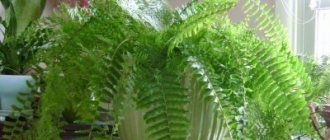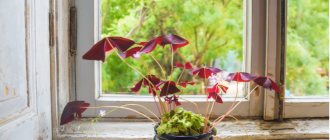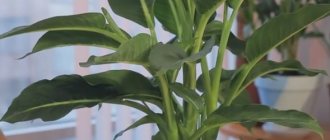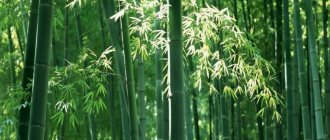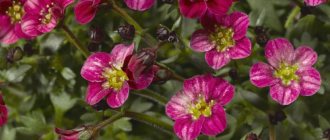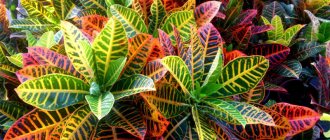Alocasia is a tropical plant belonging to the aroid family. This unusual plant is native to Malaysia, Australia and some Latin American countries. A feature of Alocasia is its large shield-shaped leaves with sharp ends. There are about 70 species of this plant in total, but not many can grow at home. Mostly at home you can find Alocasia Kalidora, Lowy, Sander and capulata. How to properly care for this plant?
Origin and appearance of alocasia
Alocasia is an evergreen shrub native to the South Asian tropics. The peculiarities of the climatic conditions of these places endowed the plant with the specific ability to release excess moisture through the surface of the leaves, which accumulates during the rainy season.
Interesting! Indoor alocasias are also sensitive to changes in humidity. They can notify about waterlogging or warn about upcoming rain by droplets protruding on the leaves.
Alocasia is one of the most beautiful representatives of the Araceae family, characterized by highly decorative leaves . It is noteworthy that they all grow from a short, almost invisible stem, creating the illusion of its absence. In this way, a luxurious evergreen bush is formed, although alocasia is considered a herbaceous plant. The rhizome of Alocasia looks like a tuber. The height of different types of this plant ranges from 30 cm to 2–3 m. This allows the gardener to choose a specimen that suits his desires and capabilities.
There are about 4–8 leaves on one bush. It is noteworthy that when the fourth leaf appears, the process of natural death of old leaf plates begins. However, even with such a small number of leaves, the plant looks simply enchanting.
The main decoration of alocasia is its unusual leaves.
The leaves of most types of alocasia are quite large (up to 50 cm in length), hard, with a glossy surface. Their shape resembles a heart with pointed corners and curly edges. The clear and relief veins of a light tone attract attention.
The alocasia flower is quite inconspicuous compared to the leaves. It looks like a peculiar sailboat with a pinkish, yellowish or greenish sail and a cob-shaped mast.
The alocasia flower is quite modest
House alocasia rarely blooms. And although the main beauty of this plant is in the leaves, it is pleasant to contemplate the graceful flowering of the plant and inhale the aroma of the flower. You just need to create the necessary conditions for alocasia, which is not so difficult to do. After all, this tropical plant is well adapted to the climatic conditions of our apartments, not to mention greenhouses, where large species look especially exotic.
Important! Many experienced flower growers advise removing flower stalks even before flowering, as they take a lot of energy from the plant, which leads to stunting of leaf growth.
If a rare flower is of interest and you want to keep it, then after flowering as a result of self-pollination, fruits may appear on the cob. In the middle of each of them, as a rule, there are up to 5 seeds.
Tightly packed alocasia berries resemble sea buckthorn
Popular varieties
General characteristics are characteristic of all varieties of alocasia, but they differ in a significant variety of leaves and dimensions. Experts identify about 70 species of this tropical beauty, but not all of them are suitable for growing at home.
Let's take a closer look at the favorites recognized by flower growers:
- Sandera. It has large elongated (approximately 50 x 20 cm) leaves with pointed tips and a curly edge. The dark green leaves with a mercury sheen have brightly “drawn” white veins. The leaf blade has a light edge. The leaves are formed on powerful petioles about 60 cm high.
- Polly. This is a variety of Sandera, which is distinguished by more patterned leaf edges and relatively frequent flowering.
- Amazonian. A smaller variety of Sandera, 40–60 cm high. It is distinguished by almost smooth leaf edges, without teeth.
- The Dragon. A low (30–40 cm) plant with leaves in the form of rounded hearts, colored light green with dark green veins.
- Large-rooted . This is a representative of large species of alocasia. The height of such a plant is about 2 m. The length of the petioles is about 1 m. The peculiarity of the leaf shape is that the edges diverge quite strongly in different directions from the petiole. This giant forms huge dark salad leaves 40 x 30 cm, sometimes up to 90 x 80 cm. During flowering, it forms a large (about 20 cm) cob with a yellow-green sail. The berries are glossy, dense, juicy red. This variety of alocasia has a variety with elegant leaves covered with white spots and more modest sizes.
- Klobuchkovaya. It can grow up to 1 m. The leaves are green, with raised veins. Their shape is similar to a regular heart with a sharp end. The average sheet size is 25 x 15 cm.
- Copper red. The type most adapted to indoor conditions. It is distinguished by rounded edges of leaves with an average size of 30 x 15 cm. The front part of the leaf plate has a greenish-copper color with a glossy sheen, and the lower part is purple. The veins are dark green.
Species diversity of alocasia in the photo
Alocasia largeleaf - the largest type of alocasia
Clear white veins are a feature of the Sandera variety
Alocasia Polly - Sandera hybrid with more pointed and curly leaves
A distinctive feature of copper-red alocasia is the reddish-green color of the leaves.
Alocasia capularis - a variety with plain heart-shaped leaves
Alocasia Dragon is distinguished by rounded leaves and dark veins
Alocasia Amazonica is a hybrid of Sandera with smoother serrations on the leaves.
Seasonal conditions of detention
Alocasia, like all tropical plants, is quite demanding of humidity, heat and light. However, growing a luxurious tropical beauty on your own windowsill is not so difficult. You just need to create the necessary conditions for it.
Specifics of seasonal maintenance at home - table
| Season | Temperature | Humidity level | Features of lighting | Optimal placement | Air composition |
| Spring | 21–26 degrees | High. Spray every three days. In hot weather - every day. | Particularly intense for newly planted plants. For green-leaved plants, light shading is possible. Complete exclusion of direct sunlight. | Window sills facing east or west. | Fresh air from a ventilated area. Complete exclusion of drafts. |
| Summer | |||||
| Autumn | |||||
| Winter | Minimum 18 degrees. Elimination of sudden temperature changes during ventilation. | High. Weekly spraying. The warmer the room, the more often the spraying. | Artificial additional lighting for 1–2 hours for varieties with variegated leaves. | South window. |
Is the plant poisonous?
The plant is toxic to people and pets due to calcium oxalate crystals contained in its sap. However, this is more of a defense mechanism, and consumption of the plant tends to have unpleasant side effects and is rarely fatal.
Specifics of care
How to water a plant
Alocasia, as a native of the tropical forest, is very moisture-loving. During the warm season, it requires abundant watering every other day. But under no circumstances should water accumulate in the pan. Alocasia also reacts positively to leaf moisture. Daily spraying will only benefit her.
In winter, watering should be reduced. The amount of water a plant needs is directly proportional to the thermometer reading. The frequency of watering is equal to the time it takes for the surface of the substrate to dry to a depth of 1 cm. In dry climates, spraying should be continued. However, it is advisable to do this only in the morning hours of sunny days.
Important! The best effect is achieved by watering with softened (settled or boiled) water. For winter watering you need water heated to 20 degrees. Not only drying out of the soil, but also its soaking can be fatal for alocasia.
Top dressing
The optimal regime for fertilizing alocasia with organic or complex mineral fertilizers is evenly, with an interval of 14–15 days during the period of active growth (April - September). The plant gratefully accepts complex fertilizers intended for decorative deciduous plants.
Complex fertilizers are suitable for alocasia
Important! The dosage of fertilizers is taken at half the amount specified by the manufacturer.
In winter, fertilizing should be reduced to once a month.
Bloom
Not everyone has seen alocasia bloom, because it blooms extremely rarely. At the same time, it begins to intensively shed its beautiful leaves. To prevent this process, you can go in two ways:
- cut off the resulting peduncle, preventing the flower from opening, and sprinkle the cut with charcoal powder;
- Allow the alocasia to bloom by feeding it with fertilizers for flowering plants.
The faded peduncle must be cut off so as not to further deplete the plant by ripening the berries.
Rest period
This period is weakly expressed in Alocasia. It’s just that with the onset of cold weather and decreasing daylight hours, it grows leaves less intensively. The gardener’s task during this period is to moderate watering and fertilizing.
What to do if problems appear with the plant?
Alocasia is quite picky and can “show character” under inappropriate conditions. To preserve the beauty of a plant, it is necessary to correctly and timely respond to a signal about a problem, knowing why this or that phenomenon occurs. Let's decipher the most common of them in the table.
Problems of caring for alocasia - table
| Signs of erroneous care | Causes | Ways to fix errors |
| Slow development during the growing season. | Lack of nitrogen. | Feed with nitrogen fertilizers in a lower dosage (1 g per liter of water). |
| Lethargy of leaves. | Overmoistening or overdrying of the soil; unsuitable soil composition. | Replant and water according to the rules. |
| The edges of the leaves dry out. | Severe dry air. | Humidify the air more often using a spray bottle or other means. |
| Dark spots on leaves. | Blowing through drafts. Low temperature. Sunburn. | Move the plant to a protected place. Shade from direct sun. |
| Leaf fading. | Poor lighting. | Move to brighter light or provide artificial lighting. |
| Yellowing of leaves. | Drafts, temperature fluctuations. Watering with hard chlorinated water. | Move the plant to a protected place. Set aside or boil the water. |
| The plant has dropped its leaves. | Exhaustion of the plant by flowering. Malnutrition. | Remove the peduncle. Feed the plant according to the rules. |
| Drops of water appear on the leaf plates. | Excessive watering. | Pour water out of the pan. Allow the soil surface to dry. Water according to the rules. |
Manifestation of errors in caring for alocasia - photo gallery
Exhausted alocasia sheds its leaves
The result of improper watering and fertilization is the wilting of alocasia
Inadequate maintenance conditions harm the decorative appearance of the plant.
The result of hypothermia and improper watering is yellowing of the leaf plate
Planting, transplanting, propagation
Alocasia is replanted in ideal conditions once every 4 months. Actions depend on whether the bush will be divided or not. If it is necessary to divide the plant, clear the rhizome from the soil. If the goal is a simple transplant, the earthen lump is not removed.
You can propagate this tropical beauty:
- rhizome (looks like a tuber);
- cuttings;
- seeds.
Planting of seeds is carried out in the spring in sand with peat, deepening it to 1 cm. Then the crops are watered and covered with film, creating a greenhouse effect. After 18-22 days, shoots appear. Small sprouts are planted in separate containers. The usual decorative leaves can only be seen on one-year-old plants.
Diseases and pests
A plant kept in unsuitable conditions is most susceptible to disease and pest damage. The main ones, as well as methods of treating affected alocasia, are discussed in the table.
Control of diseases and pests of alocasia - table
| Diseases and pests | Manifestations | Causes | Consequences | Corrective Actions | Preventing defeat |
| Root rot | Stunting of growth, lethargy and deformation of leaves, their falling. | Constant soaking of roots. | Stopping the plant from feeding. |
| Watering according to the rules. |
| Aphid | Colonies of small insects of green, gray, orange color on young leaves, their deformation, lethargy. | Introduction with soil or other plants, entry through open windows. | Sucking the juice from the plant, leading to its death. |
| Inspection of purchased plants. Roasting the soil. |
| Shchitovka | A scaly pest that looks like brown tubercles tightly attached to the plant. | Introducing with soil or other plants. |
| Inspection of the petioles of the leaves of the purchased plant. | |
| Spider mite | Formation of white spots on leaf blades. Entanglement of leaves with cobwebs. | Drying air. Infection from other plants. | Treatment with Actellik (2 ml per 2 liters of water). | Inspection of purchased plants. Roasting the soil. | |
| Mealybug | Small insects that secrete a white cotton-like substance. |
| Plant inspections in the off-season. Washing leaves from the shower. Maintaining high air humidity. | ||
| Whitefly | Small flying insects that secrete a shiny honeydew. | Introduction with soil or other plants, entry through open windows. | Creating a favorable environment for the development of sooty fungus, leading to stunting of plant growth and death. | Single treatment with Confidor (0.1 ml per 1 liter of water). | Inspection of purchased plants. |
Signs of infestation and insect pests in the photo
Dangerous scales on petioles - scale insects
Aphids are a dangerous pest that stops plant growth
Enlarged view of a spider mite
The cotton-like coating secreted by mealybugs contributes to the development of sooty fungus
Root rot is the result of the plant's root system becoming soaked.
Whitefly settles on the underside of leaves
How to fight spider mites - video
Use in folk medicine
In South America and the tropics of Asia, alocasia is known as a medicinal, but at the same time, poisonous plant: the juice is very toxic and can cause poisoning and severe burns. But when used skillfully, it becomes a powerful medicine for colds, joint diseases, and oncology. Many bioactive substances with strong antimicrobial, anti-inflammatory, and immunostimulating effects have been isolated from the plant juice.
Different parts of the plant of different varieties are used by traditional healers to treat various ailments. For example, the stems are used to prepare medicines for the stomach and toothache; pneumonia, tuberculosis and other pulmonary diseases are treated with preparations from the leaves; potions are made from the roots to reduce edema and tumors of various origins. Healers prepare alcoholic tinctures, ointments, gels, and rubs from parts of the plant.
Reviews about growing
Advantages: very beautiful ornamental plant.
Disadvantages: poisonous. I’ve been wanting to buy Alocasia for a long time, but then my husband brought me a shoot from work. Of course, I was pleased and planted it in a beautiful pot. It hasn't grown at all for a very long time, only now, in the spring, it started. What attracts me most about it is the unusual shape and decorative dark green color of the leaves, with bright white veins. This is what I have, and there are also ones with red or purple veins. Of course, since the plant is very poisonous, it should be kept away from children. Alocasia should be watered quite often as the soil dries out, and fertilized during the period of active growth. I fertilize once a month with complex fertilizer. helen-vay
https://otzovik.com/review_933443.html
Pros: handsome!
Disadvantages: capricious, does not take root well in our conditions. Oh, this Alocasia Polly. I bought it in winter. I replanted it in new soil for alocasia, added vermiculite, and finely chopped sphagnum. Added drainage to the bottom. Just a couple of days later, yellow spots appeared on the leaves, then the leaves themselves began to turn yellow. I dug it up and discovered that the bulb and roots had begun to rot. No matter how I tried to revive the bulb, nothing worked. Later I read that alocasia is very prone to rotting bulbs, you need to be careful with watering. Tim82
https://irecommend.ru/content/alokaziya-polli
Alocasia was given to me for my birthday at work.
There were 2 leaves))) Now the beauty has grown, she even wants to bloom! I don’t make any special efforts to grow it, I just don’t put it in the sun and try not to overwater it. Tatiyanna77
https://irecommend.ru/users/tatiyanna77
Watering
Features of watering depending on the season:
| Season | Features of watering |
| Spring-autumn | Abundant. Root watering is combined with surface irrigation (several times a day). |
| Winter | Regular, medium (the soil is not allowed to dry out). |


